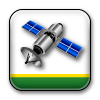 Table of Contents
Table of Contents
 Table of Contents
Table of Contents
Illustrates where satellites are in relation to machine's receiver. Sky Plot allows operator to look at satellite geometry.
Satellite information pages now show the number of satellites used in the Velocity Solution and in the Position Solution. On previous receivers, only the number of satellites used in the Velocity Solution was displayed. Position Solution uses data with the highest confidence levels to calculate the receiver’s true position. Velocity Solution uses data from as many satellites as possible to calculate intermediate values based on the previously calculated position solution. As a result, Velocity Solution count will usually display a higher number of satellites than the Position Solution.
Reading Satellite Sky Plot
Sky Plot is fixed so that North is always at top.
Satellites are displayed as their satellite ID number that correspond to Satellite Tracking Chart located right of Sky Plot.
Red – Indicates satellite is in search mode.
Blue – Indicates satellite is being tracked.
Green – Indicates satellite is OK (being used for corrections).
Sky Plot consists of three concentric rings depicting 0, 30, and 60 degrees of elevation with directional crossbar intersection representing 90 degrees of elevation.
Gray radial lines extending from center of Sky Plot represent azimuth. They are spaced 30 degrees apart and represent 30 and 60 degrees.
Directional crossbar representing North, South, East, and West also represents azimuth at 0, 90, 180, and 270 degrees.
A graph illustrating L1 and L2 (G1 and G2 for GLONASS satellites) SNR values.
Bars are colored to satellite's current status.
SNR values (colored bar) are above dashed line running horizontally across bar graph.
NOTE: Only green bars are used in calculation of PDOP, VDOP, AND HDOP. SNRs are considered good when above dashed line.